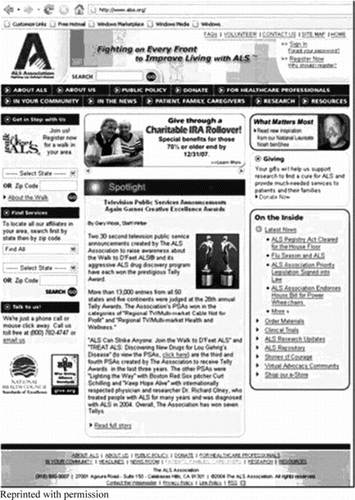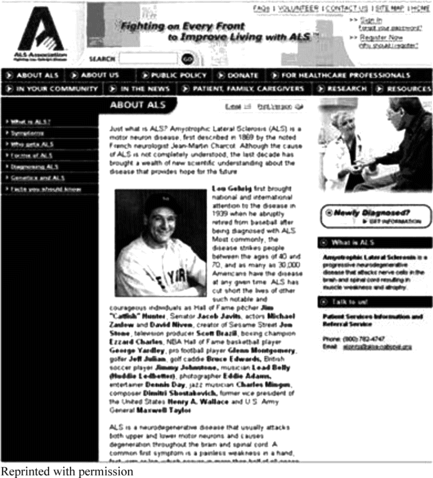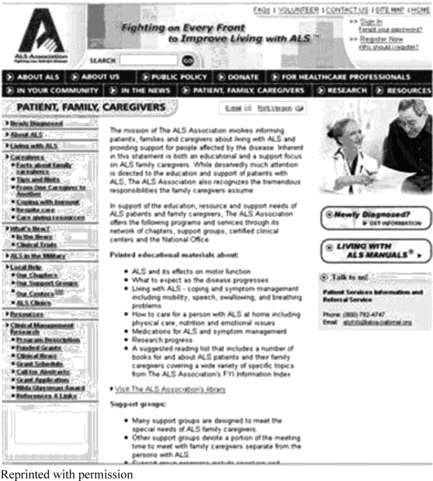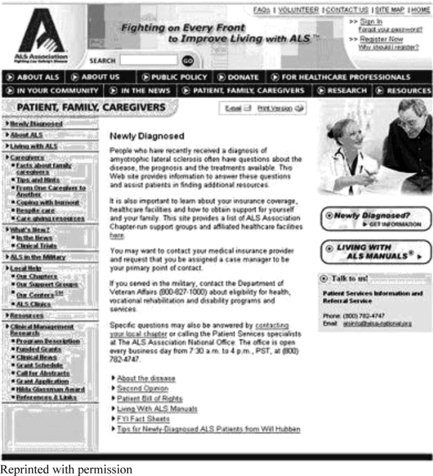ABSTRACT
Amyotrophic lateral sclerosis (ALS), most commonly known as Lou Gehrig's disease, is a progressive neurodegenerative disease that attacks nerve cells in the brain and spinal cord resulting in muscle weakness and atrophy. The ALS Association's national Web site provides comprehensive information on a wide variety of topics pertinent to ALS patients, caregivers, family members, and health care professionals. This well-organized, easy-to-navigate site is an excellent resource for anyone seeking to learn about ALS.
INTRODUCTION
Amyotrophic lateral sclerosis (ALS) is a degenerative neuromuscular disease that affects many people in the United States and abroad. The disease is most often known by its colloquial name, Lou Gehrig's disease. A diagnosis of this progressive, ultimately fatal, disorder is emotionally traumatic for patients as well as their family members and friends. The purpose of this article is to describe the data available on the ALS Association's (ALSA) national Web site <http://www.alsa.org> with a goal of assisting librarians in providing useful, relevant, and accurate information about the disease (ALS) and its progression, current treatment options, and the many resources available to assist patients and caregivers.
The home page for the site employs a red, blue, and white color scheme and a very easy-to-read style. Upon opening the site, users have a wide variety of options to learn about the disease, the organization, current events, news articles and research, advocacy, and donations. Users can also locate resources for local ALS organizations and groups, as well as the contact information for the national association.
The home page (see Figure ) is well organized and easy to navigate. The page is divided into five main visual sections:
-
the top (logo, graphics, search box, main menu bar with headings),
-
the left sidebar (upcoming walk fundraisers, find services, contact information, and links to National Health Council and the Better Business Bureau),
-
the center page (features a rotating information display and a spotlight article),
-
the right sidebar (links to new articles, latest news, giving), and
-
the bottom (association address, links to webmaster, privacy policy, link policy, and RSS).
Each area is divided into boxes, each with its own headers and information links. As a user navigates around the site, the right and left side panels change to reflect the topic of interest, and the center section serves as the main information presentation area.
The main header contains the ALSA logo, a search field (next to logo), hotlinks (top right), registered user sign-in (far right), and main content headings menu (along bottom of entire header); this header remains at the top of the screen throughout site navigation. The search field allows visitors to type in a keyword, click a red “GO” button and be directed to a new page containing a list of hotlinks (with descriptions) to articles and information within the site relevant to their search term. The hotlinks quickly direct users to frequently asked questions (FAQs), volunteer information, ALSA contact information, a site map, and ALSA's home page. The main content menu is composed of a variety of different headers in dark blue boxes. Each menu offering has its own drop-down menu, which appears automatically when moving a cursor over the heading. While the drop-down menus associated with the main headers are fairly comprehensive, the search option provides visitors with a fast way to access specific information without needing to explore the drop-down menus. The combination of different search strategies is a benefit to site users. By giving the opportunity to search for information using a variety of different avenues, users have the flexibility to individualize their searches.
All pages within the site have boxes located in the right sidebar that provide users with information for individuals, groups, or organizations to contact to receive additional assistance, referrals, or patient services information. All pages include options to e-mail or to print the page simply by clicking one of the red links located on the top of each page.
It should be noted that the ALSA Web site contains substantial information for a variety of different individuals within the ALS community, including patients, family members, caregivers, and health care professionals. This article focuses on areas that a patient or a family member might investigate when first using the ALSA Web site after a new ALS diagnosis, and discusses the various types of information that can be found on the site as well as navigational features of the site.
INFORMATION TYPES
The ALSA Web site contains a variety of different types of information, all of which help give patients, caregivers, and anyone seeking to learn about ALS a well-rounded resource. The information fits into at least three different categories, which may be described as follows:
Facts
This category provides basic facts regarding, among others, a variety of aspects of the disease itself, community events, organizations, health care facilities, legislation, and research updates. Factual information includes public education, contact names, addresses, telephone numbers, e-mails, and Web links to other ALS groups and organizations.
Opinion
This category provides the ALSA's stance on controversial issues such as end-of-life choices and stem cell research, as well as thoughts from patients and caregivers regarding various issues related to ALS. Opinion pieces provide perspectives for consideration to information seekers who may not be familiar with current events or issues surrounding ALS.
Support
This category provides a personal perspective of living with ALS from patients and caregivers as well as the spirituality and compassion of those serving the ALS community. Supportive information is provided by individuals who share their experiences, stories, thoughts, ideas, fears, dreams, and hopes. The ALS Association's National Laureate poet, Noah benShea, also writes an uplifting weekly article for the site.
The ALSA.org site offers information seekers an excellent mixture of scientific and clinical information and facts, a variety of links to other people and organizations and an array of personal support, comfort, and inspiration.
Throughout this article screen shots are shown to illustrate different areas within the ALSA.org Web site and to provide visual reference to descriptions of available information, site organization, and navigation. Information in the ALSA.org Web site is updated frequently; therefore, the figures shown in this article may differ slightly from what an individual will see on-screen upon viewing the site at a later date.
ABOUT ALS
A disease diagnosis usually causes a patient, his or her family, and friends to seek information about the disease, its history, course, drug and other therapies; what to expect during treatment; and other aspects of the illness. Located just under the ALSA logo on the top left of the ALSA.org home page is a main heading called “About ALS” (see Figure ). This heading is most likely where a majority of new visitors to the site will begin their search for information.
As mentioned above, “mousing over” any main heading on the home page of the ALSA Web site with the cursor automatically highlights that category and causes a drop-down menu with subheadings to appear. Once a heading from the main menu is selected, the user is presented with general information about the topic in the center screen area. The first page in the “About ALS” area presents a short history of ALS along with names of well-known individuals who have had the disease; it also provides a synopsis of ALS symptoms and causes, incidence rates, current drug therapies, and research. The “About ALS” subheadings offer the following topics: “What is ALS?,” “Symptoms,” “Who gets ALS,” “Forms of ALS,” “Diagnosing ALS,” “Genetics and ALS,” and “Facts You Should Know.” Clicking on any of these subheadings directs a user to a new page containing detailed, easy-to-read and understand information about the disease.
Each content page uses a similar design and layout; this consistency in layout enables users to quickly become comfortable with navigating the site. Every content page also has a unique color scheme, which is helpful to indicate that one has moved from one main page to another. The area within the center section of all content pages is organized similarly – a bold blue heading is followed by short (sometimes bulleted) paragraphs describing each topic, and, if applicable, a link or links to additional information is provided.
PATIENT, FAMILY, CAREGIVERS
The “Patient, Family, Caregivers” main header drop-down list contains the following options: “Newly-Diagnosed,” “About ALS,” “Caregivers,” “What's New,” “Clinical Trials,” “ALS in the Military,” “Local Help,” “Resources,” and “Clinical Management Research.” After clicking on the “Patient, Family, Caregivers” box, the screen changes to show which information is available within that category (see Figure ). The chosen category heading is now shown in large font on the left side of the screen under the main menu bar, which remains visible on the screen at all times, and all subheadings are listed below in the left sidebar. Some subheadings are listed alone, while others have information links from which one can select to view various related topics. Each subcategory is separated by a line that aids in distinguishing the categories themselves and in showing what can be found in each.
Under the “Patient, Family, Caregivers” heading, one learns about ALSA's mission and the printed educational materials that the organization provides; in addition, a link to the ALSA library is given. Following this, basic information about support groups, referral services, equipment loans, respite programs, and affiliations is presented.
After selecting a topic from the left sidebar, for example “Newly Diagnosed,” users see a short paragraph about this subject, which includes links to local ALS chapters, support groups, and ALS affiliated health care facilities, places to learn more about ALS and a new diagnosis. These links direct an information seeker to various resources, such as help locating a local ALS organization, an article describing second opinions (regarding diagnosis), an ALS fact sheet, book ordering information, and tips on living with ALS. The hours and telephone number for the national ALS Association are also shown (see Figure ). The right sidebar contains a direct link to information regarding a new diagnosis, a link to order a set of manuals called “Living with ALS,” and a 1–800 number for patient service and referral information.
As a user navigates through the various links within these pages, the left and right sidebars remain on the screen; only the center of the page changes to show the requested information. This helpful feature allows the user to focus on a topic of interest while still being able to move to other links within the category.
SCREEN INTERACTIVITY: MOVING AMONG HEADING PAGES
The interactivity between main heading screens as a user navigates through various pages is a beneficial feature of the ALSA Web site. For example, under the “Patient, Family, Caregivers” heading is a subcategory titled “Local Help.” A list of links to different ALS chapters, support groups, clinics, and health care institutions is provided on the “Local Help” page. Clicking on any one of these links automatically redirects a user to the main “In Your Community” page, where the left sidebar presents several sub-categories about ALS chapters, clinical centers and community programs, how to volunteer, upcoming events, stories of courage (submissions from ALS patients and caregivers), and annual conferences (see Figure ). The color change from the yellow background on the “Patient, Family, Caregivers” page to the green background of the “In Your Community” page is a useful indicator that one has been directed to a new page. In addition, the right sidebar changes to show boxes titled “Locate Services” and “Community Services,” which provide information to help users find ALS resources in the area in which they live.
FIGURE 5 Interactivity between Pages on the < http://www.alsa.org> Web Site

RESOURCES
The “Resources” heading provides content related to the variety of different ways a person can find additional information on ALS topics (see Figure ). From this page, site visitors can link to all the different information that the ALSA provides; these resources can either be downloaded directly or ordered online. Resource categories include a “Patient Services Resources Directory” that provides several links to a variety of issues including aging, emergency, equipment, respite, and travel, to name a few. The “Occupational Therapy Manual” provides a download with information about living with ALS, the “Books” category provides reading lists by topic area, and the “TV/Film/Radio Listings” notes films and television shows featuring ALS. “Resources” also contains the subcategories “Products to Aid in Daily Living,” which provides links to companies from which patients and caregivers can find equipment and personal care items to help with caring for an ALS patient, and “Informative Web Links,” where lists of other Web sites are provided for a variety of topics (e.g., care giving and grieving). Finally, a “Glossary of Terms” gives users definitions for many scientific and technical terms related to neurological diseases and ALS specifically.
OTHER MAIN SUBJECT HEADINGS
In addition to the “About ALS,” “Patient, Family, Caregivers,” “In Your Community,” and “Resource” pages, the ALSA.org Web site contains the following other main headings: “About Us,” “Public Policy,” “Donate,” “For Healthcare Professionals,” “In the News,” and “Research.” Following is a brief description of the types of information contained in each of these areas.
The “About Us” heading provides information seekers with an overview of the ALS Association, its mission and work. One can link to “Leadership” to learn about the Board of Trustees and the executive staff; “Annual Report” to view financial information; “Corporate Partners & Sponsors” to link to companies who directly support the ALSA; “Honorees and All-Stars” to read about individuals who have made significant contributions to the ALS community; and “Contact Us,” to find telephone, address, and e-mail information for the ALSA organization.
The “Public Policy” heading contains several subheadings related to legislation, advocacy, Medicare, and government agencies. Users can link to a variety of different legislators to submit requests and support for various pending legislation, learn more about becoming an advocate, and gain a better understanding of the current legislation affecting the ALS community.
The “Donate” heading provides information about different types of donations to ALSA, including monetary, legacy and gift planning, and vehicle donations. In addition, it provides professional advisor information, such as wording to use in a will, information about how donations are used, gift-matching programs, corporate donors, and creating a tribute fund to remember a loved one who was afflicted with ALS.
The “For Healthcare Professionals” area has information about clinical management, drug research updates, and upcoming conferences. Most of the subheadings within this section redirect a user to another main heading within the site, for example, clicking on the “Library Materials” link takes one to the main Resources page and choosing the “Clinical and Development” link takes one to the “Patient, Family, Caregivers” page.
“In the News” contains headlines and stories from national media as well as ALSA organizational news, press releases, and activities. This area contains information on how information seekers can sign up to receive e-newsletters, the ALSA magazine, and breaking news updates. It also provides media relations contacts for news media and journalists. The “News Media Services” link directs users to a new page that is designed for reporters and other media specialists working on stories about ALS and the ALS Association.
Finally, the “Research” area gives latest news on current ALS research and houses an ALS news archive; an information seeker can search for articles and projects in both the current and archive areas. This area also provides information about clinical trials, a glossary of terms relevant to ALS, and a link to view research update webcasts. Research professionals can also access information about grants and can submit applications to receive grants to fund ALS research projects. Interested individuals may also subscribe to receive research news updates from this page.
CONCLUSION
The ALSA Web site offers a wide variety of relevant, useful information for ALS patients, their friends and family, caregivers, and medical personnel. The site provides a well-rounded scope of information, from facts to opinions to spiritual and coping support. The ALSA.org Web site is easy to read and navigate, and it uses visually appealing pictures and colors. Via its site, the ALS Association promotes and advances public education, research, patient advocacy and support, caregiver assistance, help for family members, and professional collaboration among health care providers and researchers through the information it provides. This site is an excellent resource for librarians looking to advise a client seeking information about ALS – and for anyone who wishes to learn about this disease.
Comments and suggestions should be sent to the Column Editor: Lynda M. Baker ([email protected]).




